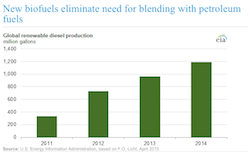A recent Today in Energy report looked at the future of the renewable diesel. Unlike other biofuels, which do not share identical properties of the fuel they are replacing, renewable diesel fuels, or hydroprocessed esters and fatty acids (HEFA) are virtually indistinguishable from their petroleum counterparts. In 2014, more than one billion gallons of drop-in fuels were produced globally and the volume is expected to increase in the coming years in part in the U.S. as the Renewable Volume Obligations (RVOs) are increased for this category within the Renewable Fuel Standard (RFS).
 According to the article, the most common HEFA biofuel production is a a diesel replacement fuel alternately marketed as hydrotreated vegetable oil (HVO) abroad, or as renewable diesel in the United States. HEFA fuels are produced by reacting vegetable oil or animal fat with hydrogen in the presence of a catalyst. There are currently 10 plants worldwide that produce renewable diesel with Finnish Neste as the world’s largest producer who is currently working with Boeing on fuel testing. Other major producers are Italy’s ENI, U.S.-based Diamond Green Diesel, and Swedish refiner Preem.
According to the article, the most common HEFA biofuel production is a a diesel replacement fuel alternately marketed as hydrotreated vegetable oil (HVO) abroad, or as renewable diesel in the United States. HEFA fuels are produced by reacting vegetable oil or animal fat with hydrogen in the presence of a catalyst. There are currently 10 plants worldwide that produce renewable diesel with Finnish Neste as the world’s largest producer who is currently working with Boeing on fuel testing. Other major producers are Italy’s ENI, U.S.-based Diamond Green Diesel, and Swedish refiner Preem.
Another outlet for HEFA fuels using similar technology is biojet fuel, which can currently be blended with petroleum jet fuel in proportions up to 50 percent. Many global airlines have begun conducting test flights using various biofuel fuels produced from a multitude of feedstocks including camelina. In the U.S. the Department of Defense is testing these fuels as well with the U.S. Navy and U.S. Air Force leading the way.

